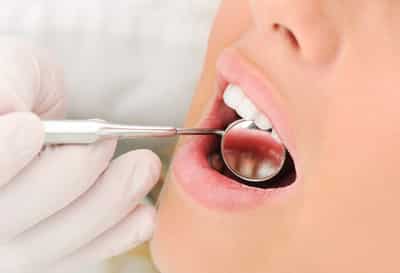
White spots on teeth can range from a single dot on one tooth to spots or marks on many teeth. The first step is to work out why you’ve got white spots and then if they need to be treated.
What can cause white spots on teeth?
1. Tooth decay (hypocalcification)
Tooth decay (hypocalcification) is one of the most common causes of white spots and it’s due to a loss of mineral content in the teeth. There are many causes of tooth decay such as those listed below.
Poor oral hygiene causes a build up of dental plaque and this can lead to the breakdown of teeth, which can look like white spots in the enamel.
Acidic drinks can strip the mineral from teeth, even if sugar free. The loss of minerals can lead to the appearance of white spots on the teeth. The first stage of treatment is to stop drinking them immediately and replace them with water where possible.
A diet that is high in sugar can cause white spots on teeth that often develop into decay. The first stage of treatment is a change in your diet, limiting the amount of sugar you eat.
A dry mouth can lead to the saliva becoming acidic and the loss of mineral from the teeth. Many things such as medications, dehydration and medical conditions can cause dry mouth. A diagnosis of what is causing the dry mouth is really important and if things can be changed, ie. A different medication, then it’s important to do so.
Stomach acid is damaging to the teeth and can cause white spots. Gastric reflux is one of the most common reasons why we can get acid damage to our teeth. Conditions such as morning sickness, sickness that leads to vomiting and bulimia can also lead to white spots on the teeth.
In all of the above examples of tooth decay, it’s really important that you visit your general dentist. Ask for a dental exam with radiographs (x-rays), a thorough scale and clean with oral hygiene instruction, and then treatment of the white spots/tooth decay. It’s then essential to return for regular visits with the general dentist for maintenance.
2. Fluorosis
Fluorosis occurs when you consume excess fluoride whilst the teeth are being formed in the first eight years of your life. It tends to affect most of the teeth and can range from mild white spots or lines to brown spots. It can also make the enamel rough and pitted.
Treatment is available with the general dentist and it depends on the severity of the condition.
Mild fluorosis can often be treated with tooth whitening and micro-abrasion, helping the white spots fade into the natural tooth colour.
Severe fluorosis may involve the use of composite resin white fillings or porcelain veneers. If the enamel is pitted you can be more susceptible to tooth decay and it’s important to see the general dentist regularly for check ups and x-rays.
3. Genetic disorders
Amelogenesis Imperfecta is a genetic disorder that disturbs the development of the teeth. It can affect the baby and adult teeth, and is caused when the enamel is forming and the proteins malfunction during the process.
It can lead to an increase risk of tooth decay and tooth sensitivity and if you suspect you or a family member are suffering from this condition, seeking diagnosis and treatment with your general dentist is important.
4. Trauma
Sometimes a single tooth can have a white spot in its enamel that can be caused by trauma to the area or a disturbance to the formation of the enamel whilst the tooth is developing. It is common on the front teeth.
A visit to the general dentist to look at the area is important and sometimes micro-abrasion and teeth whitening can help lessen the appearance. In some situations treatment can involve the use of composite resin fillings or porcelain veneers to mask the spot and blend it with the other teeth.
5. Celiac disease
Celiac disease is a condition where gluten can’t be tolerated. But it can have manifestations other than gastrointestinal problems.
Celiac disease can cause white spots while the enamel is forming and this can be one of the first markers of the disease in children. Celiac disease can affect the enamel of the teeth causing white spots and defects. It can look like the condition of fluorosis or tetracycline antibiotic stains. But if there is no reason for these two conditions then a possible referral to the GP for further testing for celiac disease may be warranted.
Unfortunately the tooth defects are permanent and may warrant treatment such as teeth whitening, micro-abrasion, composite fills or porcelain veneers in older children or adults to treat the white spots.
6. Medications
Antibiotics such as tetracycline and doxycycline can cause white spots in teeth if given to a child whose teeth are still developing.
This type of discolouration tends to affect most of the teeth and treatment is tooth whitening, composite resin bonding and porcelain veneers.
If you are concerned about any white spots on your teeth you should seek a diagnosis from your general dentist. Once you know the reason for the spots then treatment can be administered from a range of options such as teeth whitening, micro-abrasion, composite resin white fillings and porcelain veneer bonding.
